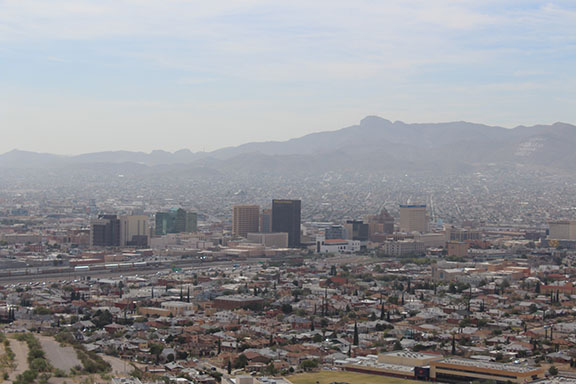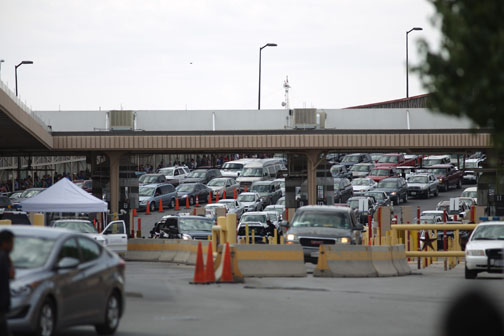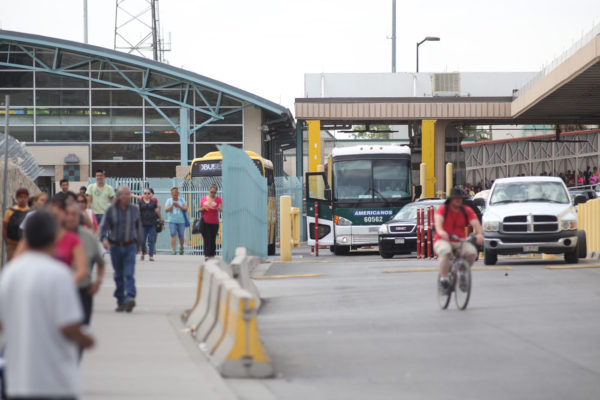EL PASO – Lower Valley resident Daniela Caro struggles to breathe some days.
“On bad days my asthma gets really bad, my throat closes up, even walking to class is a little bit hard,” she said.
 The 23-year-old El Pasoan lives near Riverside where trucks spew toxic fumes as they transport goods across the El Paso-Juarez border.
The 23-year-old El Pasoan lives near Riverside where trucks spew toxic fumes as they transport goods across the El Paso-Juarez border.
The American Lung Association ranks El Paso’s pollution in the top 20 among U.S. metropolitan areas for both particles and ozone.
Poor air quality has been linked to health issues, particularly for at-risk groups like children, older adults and anyone with respiratory problems like asthma. Officials say several factors – industry, vehicle traffic and dust – contribute to the pollution problem.
For area residents like Caro, a psychology and theater arts student at UTEP, it can be hard to catch a breath when the smog hits.

Photo by Jack Price, Borderzine.com
The high cost of heavy traffic
While El Paso shares pollution challenges with many other global cities, it has one unique contributor – cars and trucks idling at international bridges while they wait hours to cross. Two of the bridges straddle the center of the city, connecting to crowded roadways that snake out in both directions across the sprawling borderplex of El Paso and Juarez, Mexico.
“We on the border are affected by the movement of goods across the border trucks and railroad,” said Irasema Coronado, a UTEP political science professor who has done research on the border and environment. “We pay the price for that trade and it affects our quality of life, long lines, air pollution and traffic congestion.”
The heavy vehicle traffic rumbling throughout the 248 square miles of El Paso County contributes to the amount of ozone at ground level. The ozone is created by chemical reactions between oxides of nitrogen and volatile organic compounds exposed to sunlight. According to the American Lung Association, the El Paso-Las Cruces, N.M., metroplex ranks 16th out of the 25 most ozone-polluted cities in the United States. More than 1 million people live on the U.S. side of the border in the region and another 1.2 million live in neighboring Juarez.
In October 2015 the Environmental Protection Agency (EPA) lowered the ground-level ozone standard from 75 parts per billion to 70 parts per billion (ppb). The new standards were set with the aim to improve air quality and public health. The American Lung Association listed El Paso as an improving city and El Paso had 7 days over 70ppb in 2015 and 4 so far in 2016. The American Lung Association listed El Paso as an improving city.
As the amount of ground-level ozone increases, it can trigger more serious illnesses, including coughing, asthma, bronchitis, chest pain and breathing difficulties during outdoor exercise. Poor air quality has been linked to health issues, particularly for at-risk groups like children, older adults and anyone with respiratory problems like asthma.
A 2012 white paper sponsored by the Southwest Consortium for Environmental Research and Policy (SCERP) examined how long delays of idling commercial and passenger vehicles, at ports of entry like El Paso’s “present challenges for both sides of the border, including economic, social, and health issues.”
The report called for more research on border crossing health effects in the U.S.-Mexico border region because all previous research was only done at U.S.-Canadian crossings, which have different climates, infrastructures and socio-economic conditions.
In addition to ozone, a 2011 report published in the journal Environmental Research found hat dust and wind events raised the likelihood of children being hospitalized for asthma and bronchitis in El Paso.
“Since I was around five or seven, is when it started getting pretty bad,” Caro said. “I was pretty active, but then it started getting worse and worse. And I still have it.”
Pollution levels near schools ‘alarming’
A 2016 study by researchers at the University of Texas at El Paso revealed that air tested at some El Paso schools had high levels of hazardous air particles.
The El Paso Independent School District is the 10th largest school district in Texas and the 61st largest in the US, with more than 64,000 students across 94 campuses. Around 40 percent of these students are enrolled in 58 elementary schools across the district.
Air quality measured near 27 EPISD elementary schools was found to have alarming levels of hazardous air pollutants (HAPs) a Feb. 2016 study by UTEP professors found. All schools in the district had air quality levels which the EPA says can lead to the development of respiratory illnesses. According to the EPA, respiratory risk scores above 1.0 demonstrate the potential for adverse health effects. UTEP’s study looked at the USEPA 2005 National Air Toxics Assessment , which found air quality at all 58 EPISD schools recording respiratory risk estimates above 1.0. In addition, 27 schools were in areas with diesel particulate matter (PM) risk values above 1.0.
“I think pollution near our schools and in our community is a very important issue to tackle immediately. We need to be concerned about children’s exposure to pollution,” said Sara Greniski, an associate professor of sociology at UTEP, who collaborated on the study, which measured school-based exposure to air pollutants and student grade point average.
She explained that children are more susceptible to the impact of pollution than adults because they breathe in more air (per pound of body weight). They spend more time outside, and are more likely to put their hands in their mouths, increasing their exposure. Because their bodies are still developing they are susceptible to pollutants that can impact their developing organ and tissue functioning.
For asthma sufferer Caro, bad air days limited her participation in activities during her time at East Side Elementary School and J.M. Hanks High School.
“It was hard because we had to do PE classes and they wouldn’t think it was a good enough excuse for me to have asthma. they would still push me and my throat would get closed up, I had to go to the doctors,” she said.
Caro grew up in El Paso’s Lower Valley near the busy Alameda Avenue.
“I was very dependent on my inhaler those days and had to carry it around with me at all times just in case I got a random asthma attack,” she said. “… If I did get an asthma attack it would take anywhere from 45 minutes to an hour to get back to normal breathing. I would usually be wheezing all day so I had to stay indoors.”
Some communities are requiring that new schools be built away from high traffic areas. In 2011 the California Air Resources Board recommended that facilities such as schools, playgrounds and day care centers must be sited at least 500 feet or farther from major roads. The World Health Organization and the U.S. EPA have published guidelines on school locations. Ten states in the U.S. have enacted policies prohibiting schools being located next to environmental hazards, but the majority of states, including Texas, have not.
Grineski suggested that in an ideal world, children should avoid attending schools near busy roadways and polluting facilities. But she acknowledged this is not realistic.
“Instead, we have to work together to advocate for pollution reduction measures at a federal and state level and school citing policies that keep schools away from hazards,” she said.

The Paso Del Norte Port of Entry in downtown El Paso is one of three international bridges located in the city. Millions of pedestrians and vehicles use the bridges every year. Photo by Jorge Salgado, Borderzine.com
Geography, population and transit challenges
The Paso Del Norte air basin encompasses El Paso City-County, and Ciudad Juarez and Dona Ana County in New Mexico. The region’s location between two mountain ranges makes it prone to inversion layers which serve as a cap over the area, trapping in the smog.The abundant sunshine along the border also contributes to ozone formation.
The U.S. and Mexico have different regulations and air quality standards, this can make it difficult for the two nations to collaborate on shared pollution problems.
Addressing bridge traffic to ease congestion
Over 2.7 million people live on the U.S., Mexico border in the El Paso-Juarez region. The overall border population is expected to double by 2030. This increase in population and increasing trade has led to an increase in border crossings, traffic congestion and corresponding idling times at the crossings.
Around 14 million vehicles, including 760,00 trucks, passed through El Paso’s ports of entry in 2015, according to the Bureau of Transportation Statistics reported. On an average day Customs and Border Patrol processes 30,000 cars, 20,000 pedestrians and around 3,000 commercial trucks will pass through El Paso’s ports of entry, according to Roger Maier, Public Affairs Officer for CBP.
Public-Private Partnership easing trade route, cutting idle time
In early September, El Paso’s mayor and members of Congress, met downtown at a park near the Paso Del Norte bridge to highlight two years of the P3 Partnership Pilot Program. The program is designed to reduce wait times at border crossings and boost economic growth between the US and Mexico.
El Paso mayor Oscar Leeser, Congressman Will Hurd, R-Texas, Sen. John Cornyn, R-Texas and Congressman O’Rourke, D-Texas, praised the project. The program enables private companies or local governments such as El Paso City Council to contribute funds generated through bridge toll fees to pay for overtime hours for U.S. CBP staff during busy periods.
“The goal is just to move traffic more quickly through the ports of entry and to facilitate and enhance commerce in the community.” Said CBP’s Maier.
The program has cut truck crossing times by 20 minutes per truck and 12 minutes per car.
“While that does not seem like much, when you are talking about thousands of crossings a day and hundreds of thousands in the course of a year, that time adds up and it’s significant revenue,” Maier added.
The U.S. government spends $18 billion on border security, more than every other federal law enforcement activity combined. Even with all of this expenditure, border crossing checkpoints are not fully staffed, which was adding to the slow flow of traffic across the border.
During the press conference, Cornyn said that while security issues on the border are important, Washington, D.C. also needs to understand the big picture includes trade, travel and commerce and provide adequate funding for the infrastructure, and staffing needs of the border.
“What we need to do is to make sure that trade – which benefits both sides of the border, creates jobs and opportunity throughout the United States – that we make sure that commerce can flow quickly and freely across the border because of the benefits it provides both sides,” he said.
Around $90 billion worth of trade crosses through El Paso’s ports of entry each year. In 2015 El Paso exported $24.6 billion worth of goods to foreign countries, up 22.4 percent from 2014, the 11th largest exporter in the country. El Paso’s exports have grown 217 percent since 2009, when they were reported to be at $7.75 billion, 31st among U.S. metro areas. 86 per cent of El Paso’s exports went to Mexico in 2015, the El Paso Times reported.
The Las Cruces area also exported $1.6 billion in exports in 2015 – with most of these exports passing through the Santa Teresa port of entry in El Paso.

Photo by Jorge Salgado, Borderzine.com
What else to do about wait times
Congressman, Beto O’Rourke, R-Texas, released a video on social media the week of Sept. 5 following people’s journeys across the border, both from Cuidad Juarez and El Paso. O’Rourke’s video highlighted wait times which were reported to be between five minutes to two hours by car and 30 minutes to six hours for trucks.
UTEP’s Prof. Coronado thinks more should be done to improve border crossing.
“We could have inspectors from the U.S. going into Mexico, into a place where trucks are parked and lined up and have them inspect the vehicle, inspect the cargo, seal it, put it on a secure lane and send it across the border rather than having these bottlenecks.”
The 212 white paper by the Southwest Consortium for Environmental Research and Policy offers several recommendations to improve border crossings and air quality along the U.S. – Mexico border, including creating buffer zones between roadways and communities. Other ideas include:
- New technologies such as the application of new paints and coatings that catalyze pollutant gases and change them into CO2 and water, and reduce pollution levels near the treated area and vegetative barriers.
- Strengthening the air monitoring network
- State program of vehicle protection (smog check) inventories of air pollutants emissions
- An integrated program of pavement and air quality.
The report states that many air pollutants are still not routinely tested for, these include benzene, a known carcinogen, black carbon, a marker for diesel exhaust, and ultrafine particles, very small nanoparticles that are implicated in health effects ranging from cardiovascular to neurological.
Landscape and alternative transit
Dr. Carlos Rincon, EPA U.S.-Mexico Border Lead Contact Officer, highlighted dust from unpaved roads as being another contributor to ground ozone pollution in the region and contributes to PM pollution.
“In Ciudad Juarez close to 46 percent of transited roads are unpaved, and air does not respect boundaries,” he said.
“There is also the source at soils without grass cover and vegetation at regional cattle ranches that are the source of transported particulates that cause air quality problems within the shared air basin,” Rincon added.
Texas A&M Transport Institute conducted a study examining the impact that border traffic has on the air quality at the Ysleta-Zaragoza port of entry. They found that for commercial vehicles there was very little improvement in air quality when wait times were reduced.
During their 24-hour study, it was found that in order to get a reduction of more than one percent wait-time must be reduced by 25 percent. There was also little capacity for change when more inspection booths were made available as there was limited capacity for freight crossing through the ports of entry.
The reduction of booths available for commercial trucks during peak times during peak and off-peak hours resulted in a reduction of overall emissions. This is due to the amount of available capacity at the actual port of entry. Two lanes cross over the bridge and then branch out at the primary inspection facility. Having two inspection booths open compared to all eight booths open only decreases capacity by approximately 33 trucks, depending on size and vehicle type.
Camino Real Regional Mobile Authority (CRRMA) executive director, Raymond L. Telles has outlined two key projects to ease traffic congestion in the city. The organization was set up in 2007 by El Paso City Council to develop transport solutions for the city.
CRRMA runs the El Paso B Cycle bike share scheme, which allows users to pick up a bike from a designated station and return it to another B Cycle station.
They are in talks with the El Paso Metropolitan Planning Organization about potentially expanding their operation to Juarez and becoming a “truly international” system, with its main aim being getting people out of their cars and reducing emissions.
The organization has also developed an app, Metropia which enables users to map out their daily commutes and suggests ideal driving times. Unlike similar apps Metropia sends drivers heading to the same destination along different routes, cutting journey times and resulting in lower vehicle emissions.
The app, which offers real-time traffic information is still being tested but Telles said El Paso is “next in the queue” to have the get the finished version of the application.
For Caro, the day when bad air days are a thing of a past can’t come soon enough.
“If bad air days were non-existent, my asthma would be better controlled and tolerable and I wouldn’t have to use my inhaler as much. Normal activities like walking to class or running around doing stuff wouldn’t be such a hassle. The wheezing would be a rare thing and it would make it easier to breathe,” she said.
You can check the border crossing times for all of El Paso’s ports of entry here and the get updates on the region’s air quality here.
